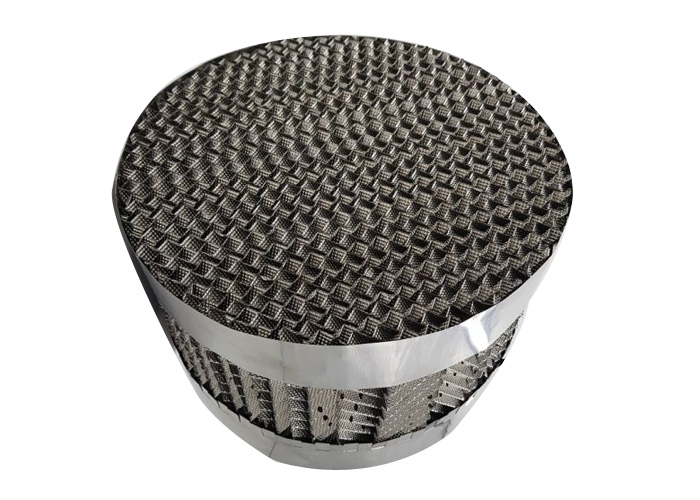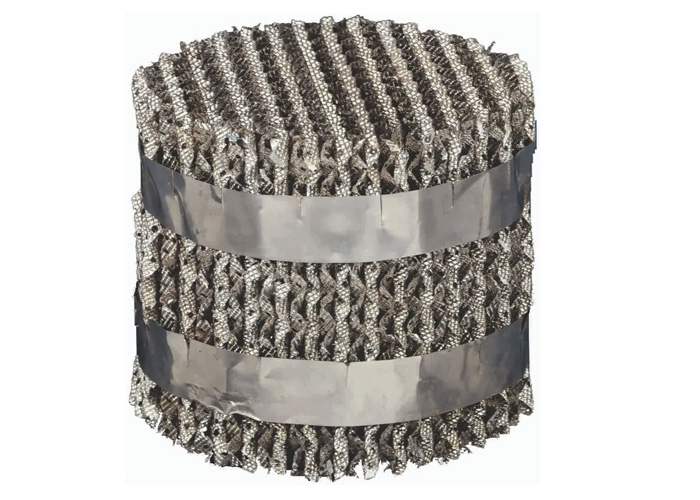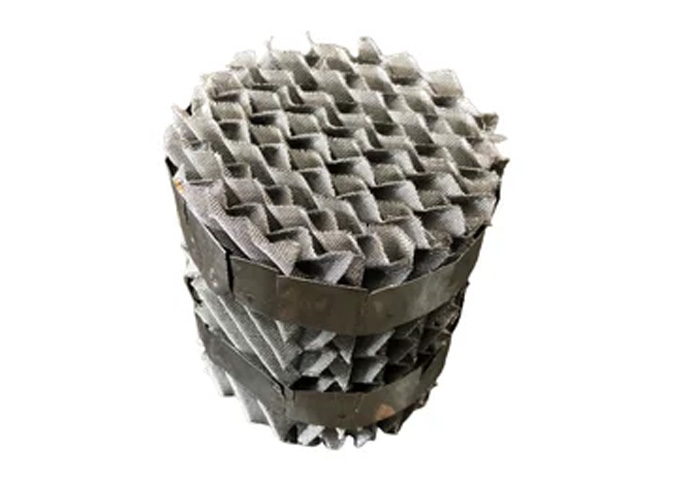Structured Packing in Distillation Column
Structured packing is a specialized material used in distillation and separation processes within industrial columns. Unlike random packing, which comprises irregularly shaped pieces of packing material, structured packing consists of specifically designed geometric arrangements, such as corrugated sheets or layers. These sheets are stacked vertically within the column to create a network of channels, maximizing surface area and facilitating efficient contact between vapor and liquid phases. This design promotes mass transfer and enhances separation efficiency. Structured packing offers advantages such as high mass transfer efficiency, predictable performance, and lower pressure drops compared to random packing. It finds wide application in industries such as petrochemicals, oil refining, pharmaceuticals, and chemical processing where precise separation is crucial for production processes. Overall, structured packing plays a vital role in achieving efficient separation and purification of chemical components.
Ambani Metals is a renowned leader among structured packing manufacturers in India, delivering unmatched expertise in the design and production of high-performance structured packing solutions. We specialize in providing X and Y types of structured packing, meticulously crafted from premium materials such as Stainless Steel, Hastelloy, and Inconel. The X type, designed with a 30° angle, offers a minimal pressure drop, while the Y type, featuring a 45° angle, ensures superior mass transfer properties to cater to a wide range of industrial applications.
Global Export of Structured Packing
At Ambani Metals, we design and manufacture high-performance structured packing for efficient separation in distillation, absorption, stripping, and extraction processes. Known for their low pressure drop and high surface area, our structured packing systems are widely used across industries such as petrochemicals, pharmaceuticals, fine chemicals, gas processing, biofuels, and air separation.
Our advanced structured packing ensures maximum vapor-liquid contact, reduced energy consumption, and compact tower design. From standard geometries to custom-engineered configurations, every packing system is crafted with strict adherence to international design codes and optimized for plant-specific performance.
Ambani Metals exports premium-quality structured packing to industrial clients and EPCs in over 40 countries worldwide, including:
- Middle East: Bahrain, Egypt, Israel, Jordan, Kuwait, Lebanon, Oman, Qatar, Saudi Arabia, and the United Arab Emirates
- Africa: Morocco, Tunisia, Ghana, Nigeria, Senegal, Kenya, Mauritius, Rwanda, Tanzania, Uganda, Zambia, Botswana, Eswatini, Lesotho, Namibia, and South Africa
- Europe: Germany, United Kingdom, France, Italy, Netherlands, Spain, Belgium, Poland, Czech Republic, Sweden, Denmark, Finland, Portugal, Hungary, Slovakia, Slovenia, Romania, and Austria
- Asia: Japan, South Korea, Singapore, Malaysia, Vietnam, Indonesia, Thailand, Philippines, Bangladesh, Sri Lanka, and Nepal
- Pan-Pacific : United States, Canada, Mexico, Brazil, Chile, Colombia, Peru, Panama, Australia, and New Zealand
With advanced design capabilities, material traceability, and full export logistics, Ambani Metals delivers structured packing solutions you can trust.
FAQs
Structured packing is a type of packing material used in distillation and separation processes within industrial columns. It consists of specially designed geometric arrangements, such as corrugated sheets or layers, stacked vertically to create channels for vapor and liquid flow.
Structured packing is characterized by its organized geometric arrangement, whereas random packing comprises irregularly shaped pieces of packing material. Structured packing offers higher efficiency in mass transfer and predictable performance compared to random packing.
Structured packing provides several advantages, including high mass transfer efficiency, uniform and predictable performance, lower pressure drops, and compact column designs. It also offers superior separation efficiency and can meet stringent process requirements.
Structured packing finds application in various industries, including petrochemicals, oil refining, pharmaceuticals, and chemical processing. It is used in processes such as distillation, absorption, stripping, and scrubbing to achieve separation and purification of chemical components.
The structured arrangement of packing material in structured packing creates a large surface area for contact between vapor and liquid phases, promoting mass transfer and enhancing separation efficiency. This facilitates the separation of components based on differences in volatility, solubility, or other physical properties.
Yes, structured packing can be customized to meet the specific requirements of different applications. This may involve selecting materials with appropriate corrosion resistance, designing packing configurations tailored to the separation process, or incorporating specialized features to address unique challenges.
The selection of structured packing depends on factors such as the properties of the fluid mixture being processed, desired separation efficiency, column diameter and height, operating pressure and temperature, corrosion resistance, fouling tendencies, maintenance requirements, and cost considerations.




